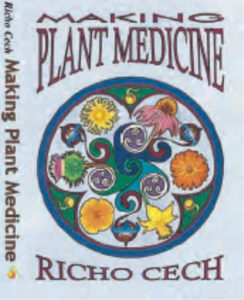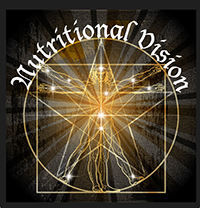BOOK REVIEW
BY KATHERINE A. CARROLL NTP.
Making Plant Medicine (Fourth Edition) by Richo Cech with Illustrator Sena Cech. (ISBN 978-0-9700312-3-5; 2016; paper-back; Herbal Reads LLC, P.O. Box 26, Williams, Oregon 97544; 336 pages; $24.95)
 Almost 22 years ago, I learned to make herbal tinctures from Dr. Richard Schulze (http://healingtools.tripod. com/biosch.html). Harassed by the Medical Mafia, he shared all of his secrets in activist-retaliation and enabled us to heal ourselves. In 1994, for the average person, there was less urgency to know how to create healing in our own kitchen. We took continued herbal availability for granted. The pharmaceutical industry was not so monstrous then. With Codex and the colluding FDA robbing us of our elite herbs and spices, ones that compete directly with the pharmaceutical companies’ and the Medical Mafia’s bottom line, it is vital to gain the experience necessary to create the home healing that the herbal pharmacy offers. Whether you garden intentionally or wildcraft, it is right outside your door. And yes, Monsanto is set on killing that too. So, it is vital to plant some-thing besides lawns and bushes. Your life will depend upon it.
Almost 22 years ago, I learned to make herbal tinctures from Dr. Richard Schulze (http://healingtools.tripod. com/biosch.html). Harassed by the Medical Mafia, he shared all of his secrets in activist-retaliation and enabled us to heal ourselves. In 1994, for the average person, there was less urgency to know how to create healing in our own kitchen. We took continued herbal availability for granted. The pharmaceutical industry was not so monstrous then. With Codex and the colluding FDA robbing us of our elite herbs and spices, ones that compete directly with the pharmaceutical companies’ and the Medical Mafia’s bottom line, it is vital to gain the experience necessary to create the home healing that the herbal pharmacy offers. Whether you garden intentionally or wildcraft, it is right outside your door. And yes, Monsanto is set on killing that too. So, it is vital to plant some-thing besides lawns and bushes. Your life will depend upon it.
What an empowering formulary Richo Cech writes. Whether a professional, manufacturer, or a layperson, you will be enlarged exponentially by absorbing the vast practical and detailed knowledge that he shares. Lest the book get dry with its textbook-style writing, Cech thoughtfully and graciously juxtaposes facts and formulations against truly talented, rich story-telling that underscores the need for education and experience to heal at home in the ways we choose. He has clearly not segregated a target market but freely given all of his ever-expanding knowledge in this fourth edition to professionals formulating for re-sale and the family in the kitchen experimenting with their first tincture.
As a reference manual, make sure it is propped up in your kitchen, spattered with use, as he desired. You’ll be inspired too by this plant medicine book. Cech says if you can grow tomatoes, you can grow these herbs. How hard is that? I have one sprouting up by the compost bin right now.
Precise, clear directions are given for every form of herbal medicine including tinctures, decoctions, infusions, creams, salves, syrups, poultices, wraps, and more. You do not have to master all of this. Just hone in on one small thing. Cech gives us so much instructional leeway, a five-year-old could qualify as an herbalist. View this book as an introduction to a lot of new “herb” friends here to help you and an invitation to invite them into your daily life. The first part of the book teaches the ways plants and herbs can be employed as healing agents. The second examines each one in precise depth. He advises, “Knowing them, their individual nuances of plant part and preferred preparation, will help you know what to make with your harvest and lead you toward appropriate usage, as well. This is local herbal medicine at its best – inexpensive, effective, empowering, and liberating!” You have a mentor at your side in Cech’s work.
A caring healer, Cech freely adds non-herbal side notes so relevant, I immediately passed some advice to a friend with an infected ulcer on her leg: raw honey on gauze pads. Epsom salts were discussed too in a departure from a strict herbal formulary; both mentioned because they work. That’s what I love about this book. He’s so real; sharing anecdotes while delivering lifesaving information. Did you know that Purslane (a common weed) is full of mucilage-like aloe and contains more Omega-3 fatty acids than any other plant? I sure didn’t and I am heading out now to pick those succulent “weeds” for dinner.
Of the herbal preparation options, take your pick. I focused on tinctures. Tincture-making can be simple or complicated. But one thing is certain, even if you forego the math and just blend everything up together, it will most likely work. But it will be best to take the few minutes to use this book as a reference to understand herbs and how they are best extracted; alcohol, a mixture of alcohol and water, hot or cold water, glycerin, or vinegar, Cech has it all figured out. Despite many herbs and plants mentioned that I was unfamiliar with, some from the Chinese and Ayurvedic traditions, there were enough common plants in my own area to assure success by beginning with what I have on hand. And I did. Lemon Balm. Hops. Both now tinctured and ready to create herbal magic.
Cech certainly shattered some myths about herbal medicine. Evidently tea is stronger than alcohol tinctures. This sentence alone inspires me. Because of pesticide and soil contamination surrounding many herb and tea growers, I am anxious to plant more herbs and to create a tea garden where we can enjoy homegrown (safe) tea every day with adaptogenic Amrita Tulsi (Holy Basil) and longevity-inducing and calming Chamomile and Lemon Balm. Blueberry and raspberry leaves I already have in abundance. Cech inspires an in-creased commitment to focus on planting – and using – edibles and medicinal herbs. It is a wise investment decision and a wise health decision. With the FDA now aiming to remove elite herbals such as ashwaganda and lobelia, we would be prudent to grow our own and become plant-pharmacists.
The illustrations are done by Sena Cech, Richo’s lovely daughter. A carryover from child-hood doodling, they are cartoon-like mice. I would have appreciated renditions of the herbs to increase my ability to identify them. Still, this book is a gift to mankind for self-empowerment in healing. It raised my already high level of appreciation for plant-life and the intimate connection we share. This book is elevating my health and my life and it will do the same for you too.

No Comments Yet